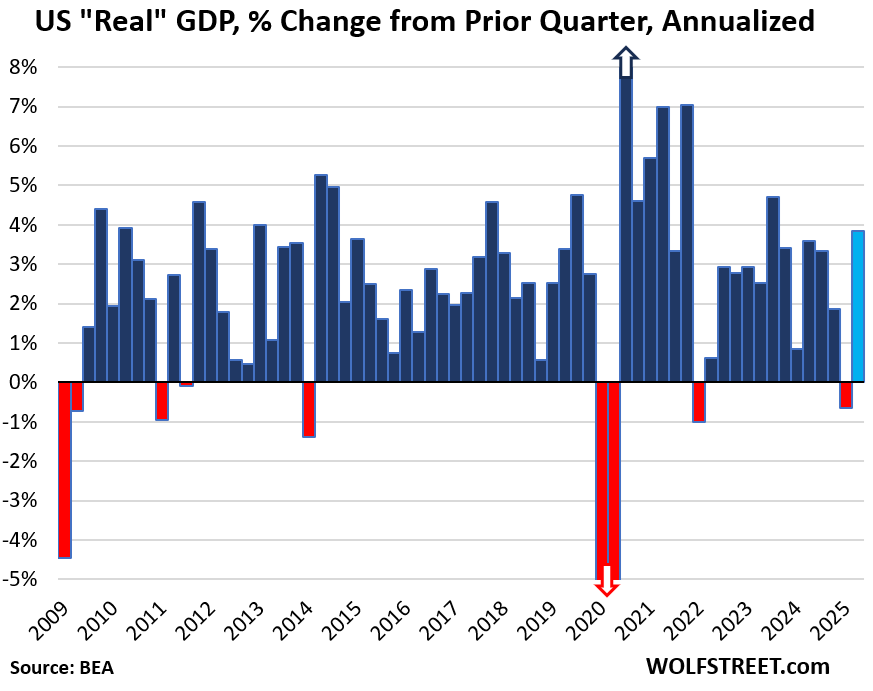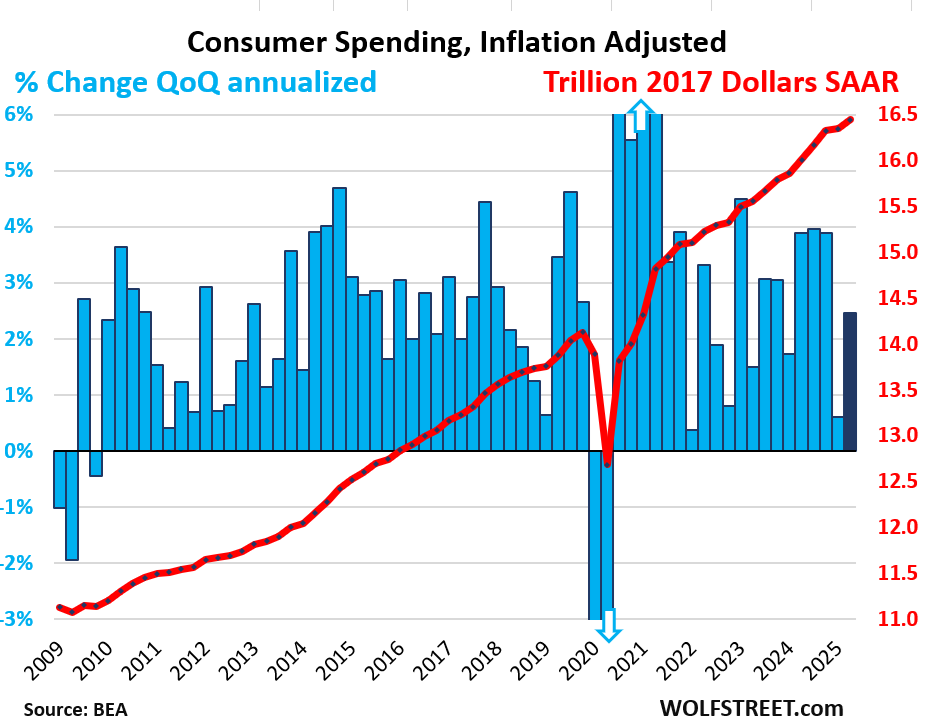What Slowdown? Q2 GDP Growth Revised Up to Hot Zone of 3.8%, Stronger Consumer Spending & Private Fixed Investment
by Wolf Richter • Sep 25, 2025 • 18 Comments
Government consumption and inventories were a bigger drag though. All adjusted for inflation.
By Wolf Richter for WOLF STREET.
Back on July 30, the “advance estimate” of GDP for the second quarter showed 3.0% growth, held down by anemic consumer spending growth and plunging inventories. The “second estimate,” released on August 28, revised GDP growth for Q2 higher to 3.3%.
Today, the “third estimate” of Q2 GDP revised Q2 GDP growth to 3.8%, the fastest growth since Q3 2023, driven largely by a big up-revision of consumer spending. This 3.8% rate of growth is in the hot zone for the US, whose average GDP growth over the past 10 years is just over 2%. All growth figures are adjusted for inflation.
The “first estimate” of GDP growth is the one that gets all the attention in the media. The revisions are normally not the focus of any attention. For that reason, I will compare today’s “third estimate” to the “first estimate,” in part because the up-revisions were so big and cumulative.

Consumer spending growth was revised up to +2.5% in Q2. The first estimate had pegged consumer spending growth at a worrisomely anemic 1.4%, the second estimate at 1.6%. Today’s massive up-revision to +2.5%, nearly doubling the growth rate of the first estimate, was the biggest contributor to the up-revision of overall GDP growth (all adjusted for inflation).
This 2.5% is healthy growth in consumer spending. The red line shows the annualized consumer spending in 2017 dollars (right scale). The blue columns show the growth rate in percent (left scale).

Private fixed investment was revised to a growth rate of 4.4%, from the dreadfully anemic 0.4% in the first estimate. Today’s up-revision substantially contributed to the up-revision of overall GDP growth:
- Investment in equipment was revised up to +8.5%
- Investment in intellectual property was revised up to +15.0%.
- Investment in structures had plunged by 10.3% in the first estimate. This plunge was reduced to -7.5% today.
But residential fixed investment (such as construction of single-family and multifamily homes) was pegged in the first estimate at a drop of -4.6%; this drop increased to -5.1% in today’s third estimate, and lowered the up-revision of private fixed investment.
Revisions that pushed the other way v. first estimate:Net exports (exports minus imports) were revised lower, they worsened:
- Imports plunged a little less (-29.3%) than the first estimate (-30.3%); imports subtract from GDP.
- Exports fell by 1.8%, same rate as the first estimate. Exports add to GDP.
Government consumption shrank by 0.1% (federal, state, and local governments combined), compared to growth of 0.4% in the first estimate.
The plunge in private inventories worsened, and deducted 3.44 percentage points from GDP growth, versus 3.17 percentage points in the first estimate. Inventories had soared in Q1 on tariff-frontrunning, and in Q2 they undid some of that increase.
What slowdown?The strong Q2 growth came after the explosion of imports on tariff-frontrunning had knocked Q1 GDP growth into the negative (-0.6%). Consumer spending growth in Q1 was also weak. So there were a lot of concerns about growth. And the first estimate of Q2 consumer spending growth (+1.4%) did nothing to alleviate those concerns.
But the revised Q2 growth figures, especially the up-revisions of consumer spending back into the healthy range, should relieve those anxieties.
And Q3 consumer spending so far looks pretty good, as indicated by strong retail sales in July and August. So maybe the wait for the downward spiral of the economy – despite reduced government spending – may have to be extended a little further? |






